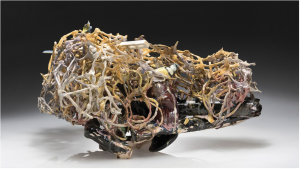
Visual arts|Arts Review
By Lucilla Burn
May 28, 2021
IN THIS REVIEW
CERAMIC
Art and civilisation
544pp. Bloomsbury. £30.
Paul Greenhalgh
In 1889, Paul Gauguin stood by the vast ceramic display at the Universal Exposition in Paris and lamented the fact that “out of ten educated persons, nine will pass in front of this section with an extreme indifference”. No one who reads Paul Greenhalgh’s ambitious, indeed monumental, work (which begins with this Gauguin moment) will do so again. Seeking to fill what he rightly identifies as a gap in the existing literature of ceramic art and production, Greenhalgh looks down on “the entire ceramic continuum from some height”, skilfully leading us through the development of western ceramics over two and a half millennia, passing through four key forces of transformation – Classicism, Islam, China and the Modern. Enormously wide-ranging, impressively researched and beautifully presented, Ceramic clearly represents the distillation of decades not just of ceramic scholarship and appreciation, but also of coherent reflection on the nature of the ceramic tradition and its place in civilization.
One of Greenhalgh’s fundamental tenets is that each new age or development carries with it and incorporates the seeds – the acquired knowledge and expertise – of its predecessors. In addition to describing exactly what innovations, technical or artistic, have occurred in successive eras and locations, and deftly relating each new type of ceramic to the society or civilization that has produced it, he wants to redress what he sees as the injustice done to ceramics by the accepted artistic canon. Here painting and sculpture reign supreme, while the cheapness of clay as a material, and the resulting low monetary value of anything made from it, has conspired with the lack of authoritative written histories of the subject to relegate ceramics to a very low rung of the hierarchy (though it could be argued that for similar reasons, in addition to their traditional designation as “women’s work”, textiles rank still lower). As part of his campaign to see pottery given proper recognition, he wants us to speak not of “ceramics” but “ceramic”, just as we refer to the art of “painting”, not “paintings”. We can certainly try to comply with this request, even if we decline to agree (as stated on pages 29 and 197) that the word “ceramic” derives from Kerameikos, the potters’ quarter of ancient Athens. There is no analogy here with “china”: “ceramic”, like “Kerameikos” itself, simply derives from the Greek words “keramos”, meaning clay, and “keramikos”, “of or relating to clay”.
Steering us from Greece to Rome, through the early medieval period, via the technological genius and innovative decorative styles of Islam and China towards the modern western world and the contemporary ceramic primacy of California, Greenhalgh offers convincing explanations and illustrations of how and why ceramic developments emerged in one European country after another, eventually moving on to the New World. Sometimes progress resulted from the interventions and patronage of powerful monarchs or emperors, sometimes through economic or political factors, such as the trading dominance of the Dutch and British East India Companies and their willingness to transport Chinese blue-and-white wares in truly massive quantities to the west: “towards the end of the 18th century”, he points out, “at least 300 million pieces of porcelain had been brought to Europe, enough to provide every man, woman and child with a complete and lavish table setting”.
Also prominent in the narrative are the startlingly talented individuals who shaped and determined the twists and turns in the ceramic pathway, such as Bernard Palissy in sixteenth-century France, with his eccentric yet brilliantly imaginative “platters”, grotesquely alive with plastically rendered frogs, shellfish and snakes; or the more sober and business-like Josiah Wedgwood in eighteenth-century Staffordshire, who systematically addressed – and lastingly transformed – “the three fundamental aspects of the industry: the quality of the material, design of wares, and the marketplace”. The twentieth-century artist-potter Bernard Leach, “hugely important for the formation of studio pottery as a global phenomenon”, receives especially detailed, perceptive and sympathetic treatment. In the final chapter (“The Creative Explosion”), which covers the years since the Second World War, Greenhalgh introduces us to a multitude of talented ceramic artists (“More people are named in this chapter than the rest of the book added together”, he admits), working hard to elucidate the individual or collective philosophies behind the often bewildering, occasionally repellent, appearance of modern ceramic. As one (superbly skilled) American late-Modern ceramic artist, Ralph Bacerra, remarked in 1992: “it doesn’t matter what you do. As long as it’s good”.
The way Greenhalgh shows and explains ceramic not just within its own tradition but simultaneously in its specific social and historical context is particularly enlightening. Here he is, for example, re-setting the superb Italian maiolica dinner services of Nicola da Urbino on the privileged sixteenth-century tables for which they were designed:
The effect must have been astounding … the notion of a multi-object orchestration of themed, polychrome wares is a tantalising one: this is ceramic as opera, as opposed to a solo performance, a total painted environment, which the audience was expected to physically interact with. Installation art isn’t as new as we sometimes think.
Greenhalgh’s writing style is highly individual, at times idiosyncratic. More rigorous copy-editing would have been useful (“practiced” appears throughout for “practised”, punctuation is occasionally erratic and the word “seminal” is overused). There are occasional passages of purple prose. (Was it perhaps an error of judgement to remark that “One’s first instinct with a good Roman red-gloss pot is to eat it. Or at least lick it all over …”?) But Greenhalgh’s enthusiasm for his subject is persuasively infectious and the narrative rarely flags over the book’s more than 500 pages. The text is enhanced by 409 superb illustrations, intelligently arranged on the page and so captioned to make the reader look, and look again.
Lucilla Burn is an expert in ancient Greek and Roman art and archaeology and formerly Assistant Director of the Fitzwilliam Museum
